Melanoma in dogs is a tumor of pigment cells and can affect a dog’s eyes, mouth, or skin. Integrative veterinarian Dr. Julie Buzby discusses the symptoms, diagnosis, and treatment of these three types of melanoma in dogs so that you can be informed and empowered.
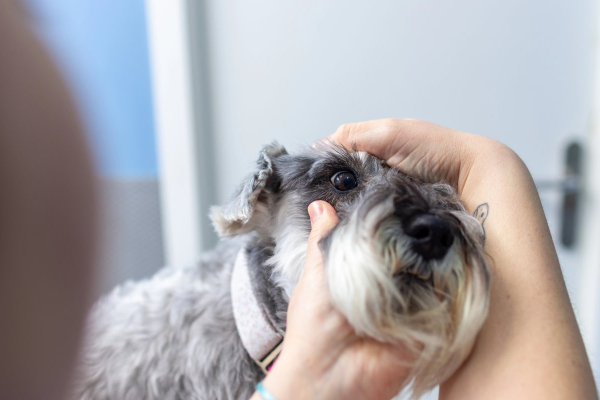
What do real estate and melanomas in dogs have in common?
Both are all about location, location, location.
Where the melanoma occurs on the dog’s body can make a huge difference in the outcome. In some places, a melanoma is likely to be benign. But in other locations, it is probably going to be aggressive and malignant.
What is melanoma in dogs?
Melanoma in dogs is a type of tumor that originates from abnormal multiplication of melanocytes, the cells responsible for producing the pigment melanin. Some melanomas are benign while others are aggressive malignant tumors.
What are the types of melanoma in dogs?
Overall, melanomas fall into one of three categories—oral (mouth) melanomas, ocular (eye) melanomas, and cutaneous (skin) melanomas.
Oral melanoma in dogs
When looking at melanomas as a whole, 80% of them will occur in the dog’s mouth. Plus, oral melanoma is responsible for over one-third of all dog mouth cancers. Out of all oral tumors, melanoma is the most common, and it also has the highest risk of metastasizing (spreading to other parts of the body). Unfortunately, oral melanomas also tend to be very locally destructive.
Oral melanoma can originate from the gums, the lips, the tongue, or the roof of the mouth. Most melanoma tumors are pigmented, but they can actually lack pigment in some cases. These non-pigmented melanomas are called amelanotic melanomas.
Breeds that have a higher risk of developing melanoma in their mouth include Dachshunds, Scottish Terriers, Golden Retrievers, Poodles, and Cocker Spaniels. Senior dogs are more likely to develop an oral melanoma than dogs of other ages.
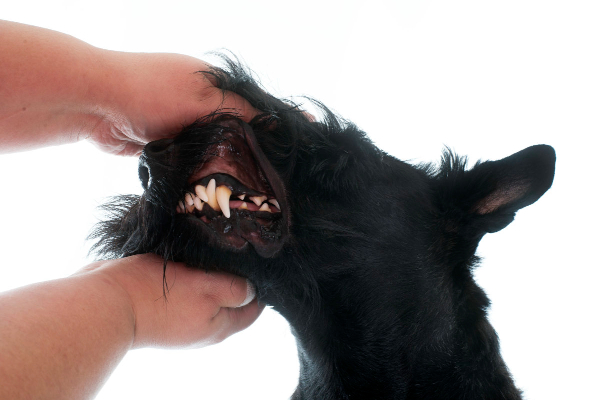
Ocular melanoma in dogs
Dog eye melanomas are the most common type of tumor affecting the inside of a dog’s eye. They tend to originate from the iris, which is the colored portion of the eye. However, melanomas can also come from the ciliary body or choroid, two other structures deep within the eye. About 80% of these melanomas in the eye are benign. But if the tumor is amelanotic (without pigment), it is more likely to be a malignant melanoma.
Additionally, dogs may develop ocular melanoma on the surface of the eye at the junction of the cornea (clear front of the eye) and the sclera (white of the eye).
Middle-aged and older dogs are more likely to develop ocular melanoma. Breeds with dark pigmentation like German Shepherd Dogs and Labrador Retrievers have a higher risk of developing ocular melanoma. But even fair-coated breeds like Golden Retrievers are at a higher risk.
Cutaneous (skin) melanoma
The good news is that 80-90% of melanomas on haired skin are benign. The location makes a big difference, though. Cutaneous melanomas are more likely to be malignant when they affect the foot pads, digits, and mucocutaneous junctions (areas where haired skin and mucous membranes meet, such as the lip margins). However, melanomas around the eyelids or from haired skin elsewhere on the body tend to be benign.
In keeping with the theme so far, dermal melanoma is more common in dogs with darker skin pigment. This includes Irish Setters, Vizslas, Schnauzers, Doberman Pinschers, and Rottweilers. Plus Golden Retrievers make the list too.
What are the symptoms of melanoma in dogs?
As you can imagine, the clinical signs of a melanoma will depend on the location too.
Signs of melanoma in a dog’s mouth
When a melanoma tumor is present in the mouth, the dogs may not have any symptoms at first. However, melanoma is locally invasive, so when the mass becomes larger, it can lead to the following:
- Excessive drooling
- Bad breath in dogs
- Trouble eating
- Facial swelling
- Bleeding from the mouth
- Pawing at the mouth
- Weight loss
- Visible tumor which may be raised, ulcerated, and pigmented (black to brown) or non-pigmented
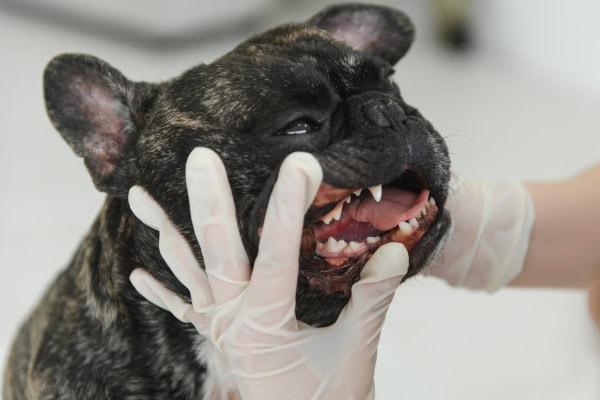
Signs of a melanoma in a dog’s eye
Ocular melanoma usually presents as a circular black or brown mark on the surface of the iris. If the mark remains flat, it is more likely to be a benign freckle. But if this pigmented lesion grows over time or becomes raised, it may be a tumor. Alternatively, you may see a mass peaking out from behind the pupil in the case of a ciliary body melanoma.
Or the dog may have a black to brown (or occasionally non-pigmented) mass growing on the surface of the eye at the junction of the cornea and the white of the eye.
Both benign and malignant ocular melanomas can cause redness of the eye, squinting or eye rubbing, increased pressure in the eye (glaucoma in dogs), inflammation of the iris and ciliary body (uveitis in dogs), increased tearing, or other eye-related symptoms. Plus, vision loss is possible in the affected eye.
Signs of a melanoma on a dog’s skin
Skin melanomas usually appear brown or black in color but can sometimes be pink. The mass is often solitary and without hair. It can be raised or flat, and it can occur anywhere on the body. Many dermal melanomas are benign. But melanomas are more likely to be malignant when present on the digits and/or when more than one centimeter thick.
How will your vet diagnose a melanoma?
Sometimes you may notice the mass while you are petting your dog or performing his or her weekly 5-minute dog health scan. Other times your vet will discover a tumor during a wellness exam. In either situation, it is important to test any new growths. How your vet does this depends on the location of the mass.
- Skin tumors in dogs are easy to access and test with a fine needle aspiration (FNA). This procedure involves using a small needle to obtain some cells from the mass. Then the vet will examine them under the microscope to determine the type of tumor and whether it is benign or malignant.
- Oral masses are firm and difficult to aspirate, so the vet may need to biopsy the mass under anesthesia instead. This allows the vet to remove a portion of the mass and send it to the lab for identification.
- Eye melanomas generally require removing the eye (or occasionally just the mass) and then submitting it to the veterinary pathology lab to reach a diagnosis.
Depending on the tumor and results, the vet may also recommend imaging such as chest X-rays, abdominal ultrasound, or a CT to look for tumor spread. Additionally, FNAs of the lymph nodes in the area of the tumor are another way to assess if the tumor has metastasized. The vet will use this information for staging the tumor and making the treatment plan.
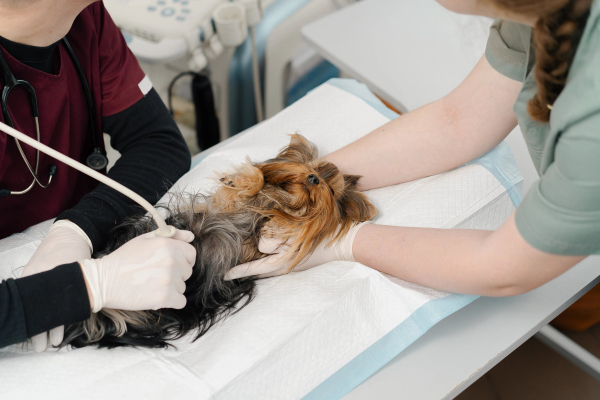
Additionally, with some types of cancer (especially oral masses), the veterinary surgeon may recommend a CT scan to help with surgical planning.
What is the treatment for melanoma in dogs?
Addressing a melanoma, especially a malignant melanoma, may take teamwork between your vet and a veterinary specialist near you (ophthalmologist, surgeon, dentist, and/or oncologist). Together they will formulate a treatment plan which may involve:
Surgery
Surgical removal of the tumor with wide margins is the primary treatment for all three types of melanomas. Sometimes with an oral melanoma, surgery involves removing local lymph nodes and jaw bone too. Also, if a digit is affected, the vet may remove the entire toe. Or with ocular melanoma that is suspected to be malignant or is causing pain and inflammation, the vet may remove the whole eye.
Malignant melanoma will usually spread to lymph nodes and the lungs, so if lesions are present on imaging, the veterinary oncologist will recommend additional therapy. Or the other treatments below may be necessary if the melanoma is inoperable.
Radiation
Radiation therapy is useful for shrinking or sometimes eliminating the visible tumor (macroscopic tumor) in about 80% of cases. This can help the dog be more comfortable. Plus, radiation can address cancerous cells that remain after surgery (microscopic tumors). However, the dog may still end up with a poor outcome due to tumor spread.
For example, there are a variety of different protocols for treating oral melanoma in dogs with radiation.
Palladia
Chemotherapy isn’t typically very effective for most melanomas, but an anti-cancer drug called Palladia® (toceranib phosphate) may be useful for some dogs with melanoma. Palladia helps by blocking specific receptors on cancer cells, preventing the growth of new blood vessels and thus starving cancer cells of nutrients.
Gilvetmab
Gilvetmab is a new product for treating some melanomas and mast cell tumors in dogs. It is an injectable antibody (immune system protein) that helps the immune system destroy cancer cells. The data from the drug company studies showed that in 60% of dogs with melanoma who were treated with gilvetmab, the tumor either decreased in size or remained stable.
At this point, gilvetmab has conditional approval, meaning that it has not yet fully been evaluated for safety, efficacy, or potency. More data is needed to understand the role it may play in melanoma treatment in the future.
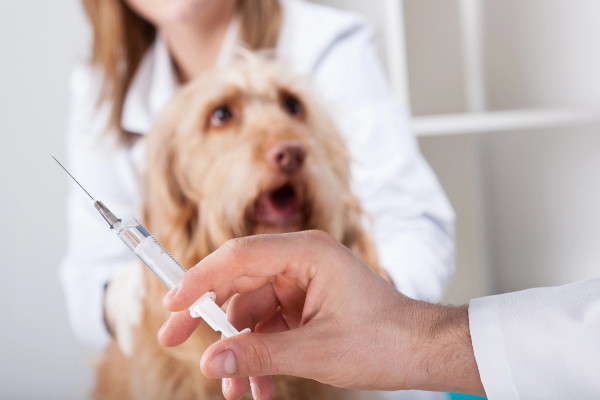
ONCEPT melanoma vaccine
Dogs with oral melanoma can benefit from ONCEPT®, a melanoma vaccine for dogs. (And sometimes vets use it off label for other types of melanoma.) The melanoma vaccine teaches a dog’s immune system to target a specific protein in the cancerous melanoma cells, thus killing the tumor cells.
Are there any holistic therapies for dog melanoma?
There are currently no proven holistic or natural treatment options that can get rid of melanomas. However, it is possible that supplements containing omega-3 fatty acids and glycosaminoglycans may be helpful for reducing inflammation in the body. Similarly, some dog parents have tried CBD oil for dogs or turmeric for dogs with melanoma.
What is the prognosis for dogs with melanoma?
As mentioned earlier, the location of the melanoma makes a big difference for the prognosis and life expectancy.
Dogs who have a benign skin melanoma have a good prognosis with surgery (and thankfully, the vast majority of cutaneous melanomas are benign). However, aggressive melanomas of the footpad, nail bed, or mucocutaneous junctions have a worse prognosis, especially if it has already metastasized. In one study, the overall median survival time (time at which 50% of affected animals are still alive) was 70 weeks for malignant cutaneous melanoma.
Most ocular melanomas are benign, which means the prognosis is overall good. However, if the ocular melanoma is malignant and has spread, the prognosis is worse. Plus, even a benign tumor has the potential to cause pain and inflammation and subsequent loss of the eye.
Unfortunately, oral melanoma patients tend to have an overall poor prognosis. Without treatment, the median survival time (MST) for dogs with oral melanoma is 65 days. And with treatment, the MST for dogs with oral melanoma ranges from 206-723 days depending on the study you look at and the stage of melanoma.
Be on the lookout for melanomas (and other masses)
Since you pet and interact with your dog on a daily basis, you are the first line of surveillance for melanomas (or any other health problems). If you notice a bump anywhere on your dog’s body or in his or her eye or mouth, please make an appointment with your veterinarian. Keep in mind that the vet may want to perform an aspirate or other tests to better characterize the mass. That way he or she has the necessary information to best form a treatment plan.
Hopefully, your dog’s mass will end up being benign, but in the event that it isn’t, remember that you are not alone. You, your vet, and potentially some veterinary specialists can work together to help your dog live a good quality life for as long as possible.
Did your dog have a melanoma?
Please share below.

